About This Book
A pamphlet published in 1910 by what was the Department of Child Hygiene of the Russell Sage Foundation. Other research areas of the Child Hygiene department included "folk dancing," "athletics," and the "use of school buildings."
A pamphlet published in 1910 by what was the Department of Child Hygiene of the Russell Sage Foundation. Other research areas of the Child Hygiene department included "folk dancing," "athletics," and the "use of school buildings."
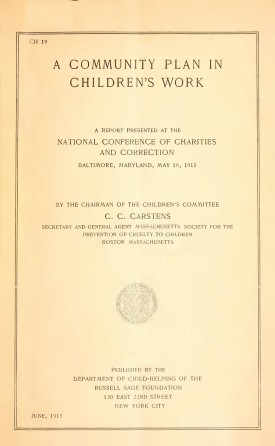
An address presented at one of 47 different sessions of the Forty-Second National Conference of Charities and Correction, held in Baltimore for a week in May 1915.
C. C. CARSTENS was secretary and general agent of the Massachusetts Society for the Prevention of Cruelty to Children.
This handbook, published in 1922, serves as an introduction to zoning, covering the spread of the movement, the reasons for zoning, the experiences of various zoned cities, and the legal pitfalls, with a discussion of the theory of community land planning legislation.
EDWARD M. BASSETT was chairman of the Zoning Committee of New York.
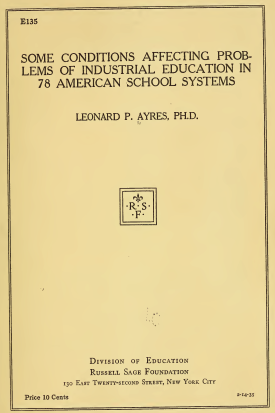
This 1935 pamphlet from the Division of Education at the Russell Sage Foundation details the investigation of American city school systems in 1913 to gather facts concerning the boys in these schools from kindergarten to the last year in high school and the fathers of these boys, to secure a more definite fact basis in the field of industrial education.
LEONARD P. AYRES was director of the Division of Education at the Russell Sage Foundation.
This article, published in the Journal of Education in 1909, argues for more research in regards to the proportion of children who enter schools in relation to how many complete the elementary course. It proposes diligent study on the number of new pupils entering public schools to better facilitate educational administrators.
LEONARD P. AYRES was director of the Division of Education at the Russell Sage Foundation.
Published in 1920, this report presents an index for measuring the effectiveness of state school systems by the amount of education received by the children and the expenditures made to purchase this education. The purpose of the index is to make it possible for state school systems to measure their progress from year to year and to compare their attainments with those of their neighbors.
LEONARD P. AYRES was director of the Division of Education at the Russell Sage Foundation.
This volume was published as part of The Pittsburgh Survey, edited by Paul Underwood Kellogg.
MARGARET F. BYINGTON was associate director of the Charity Organization Department of the Russell Sage Foundation.
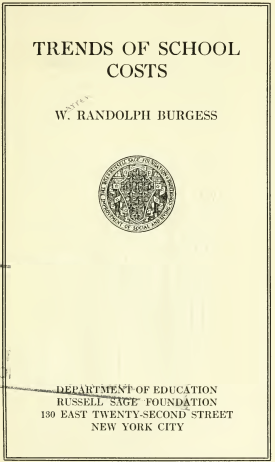
A look into the rising cost of education, Trends of School Costs was published in 1920. It analyzes the different aspects at play in the cost of public school education, including the relationship between growing attendance rates and cost. Of prime importance are trends in teachers' salaries, compared to the cost of living and the salaries of other workers. Future pricing trends are predicted.
W. RANDOLPH BURGUESS, Department of Education, Russell Sage Foundation
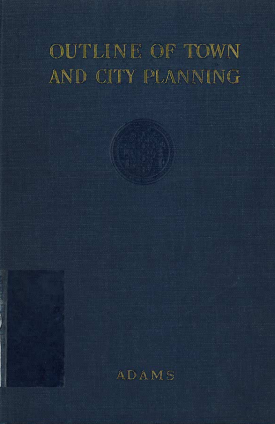
Outline of Town and City Planning, published in 1935, is a study of city planning both as an art and as public policy. The book is in one part a history of city planning, from early efforts in ancient Egypt, Asia, and the Americas, to modern day principles and the future of city planning in the United States. It is also an analysis of how changes in the character and size of cities have influenced the scope and practice of city planning.
THOMAS ADAMS was associate professor at the School of City Planning, Harvard University; special lecturer in city planning, Massachusetts Institute of Technology; and consultant to Regional Plan Association of New York.
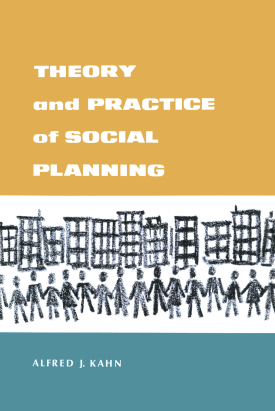
Discusses the intellectual processes involved in social planning. Professor Kahn provides critical tools for the analysis of the planning process, and shows what social planning is and can be. Clarifying the major phases in the planning process, he shows how planning can succeed or fail at any one of these stages. He examined planners in their various roles: as "neutral" technicians and as advocates, as representatives of interest groups and as public officials.
The book describes both the social aspects of planning and the relationship between social and physical plans.
ALFRED J. KAHN was professor of Social Policy and Planning at the Columbia University School of Social Work.